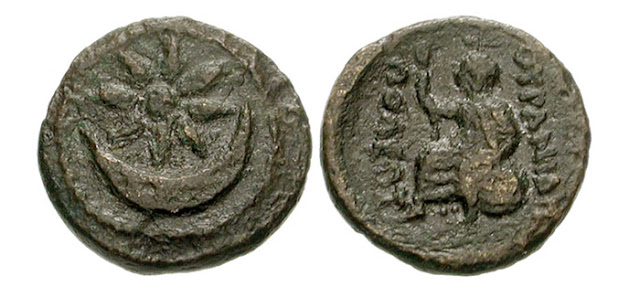At least four different Greek Goddesses have a strong connection to the Moon: Hecate, Selene, Artemis (Diana), and Aphrodite (Venus). The star and crescent appear as powerful symbols with many meanings, and are often found on ancient coins.
Athens Owl
Athens Tetradrachm - Crescent Owl
Head of Athena to right, wearing crested Attic helmet adorned with three olive leaves and palmette, round earring and pearl necklace. Rev. ΑΘΕ Owl standing right, head facing; behind, olive spray and crescent moon; all within incuse square.
The best-known crescent moon on an ancient coin is a small symbol behind the shoulder of the owl on the reverse of the silver tetradrachm of Athens, a popular trade coin accepted for centuries and widely imitated across the Mediterranean world. The crescent first appears on the coins shortly after Athens’ victory at the Battle of Marathon, fought beneath a waning moon (August or September 490 BCE). The crescent may also recall the crescent formation of the Greek ships at the decisive Battle of Salamis (September 480 BCE).
Tarentum
Tarentum Trihemiobol - Crescent and Star coin
Tarentum, a prosperous Greek city on the heel of the Italian “boot”, issued a tiny silver trihemiobol (0.78 g) c. 450 – 380 BCE showing a distaff (a tool used in spinning thread, symbolic of the local wool industry) between two stars and a crescent. On the more common and even tinier hemiobols of Tarentum (c. 325 – 228 BCE), stars and pairs of crescents, back to back, are the only designs on both sides of the coin.
Uranopolis and Byzantium
The small town of Uranopolis (“sky city”) in Macedon was dedicated to the Goddess Aprhrodite Urania. On its bronze coins (c. 300 BCE), the Goddess appears seated on a celestial globe. The star and crescent are depicted on the reverse, in a pattern that will be repeated on coins for centuries to come: the “horns” of the crescent point upward, and the star is a pellet with six or eight rays.
Uranopolis - Crescent and Star Ancient Coin
The Greek city of Byzantium (which would become Constantinople in 330 CE, and Istanbul after 1453) adopted this symbol on its coinage in the first century BCE. According to legend, in 340 BCE, when Philip of Macedon -father of Alexander the Great- besieged Byzantium, the appearance of a sudden light in the sky warned the defenders in time to prevent a surprise night attack on the walls. In gratitude to the lunar goddess Hecate, the city placed a star and crescent on its local coinage. This custom continued well into the Roman era.
Mithridates VI (135-63 BCE), King of Pontus in Asia Minor, was one of the most determined and resourceful enemies who ever fought the Roman Republic. In the year he was born, a comet appeared in the constellation of Pegasus. A fourth-century historian reported that it “burned so brightly for 70 days that the entire sky seemed to be on fire.”
King of Pontos Mithridates VI Eupator - Crescent Star
In 119 BCE another comet appeared, when 15-year-old Mithridates deposed his mother and seized the throne for himself. The star and crescent was the badge of his dynasty and it appears consistently on his coinage. A large star and crescent surrounded by a wreath forms the reverse of a unique gold stater of c. 93 BCE. On his abundant silver coinage, the star and crescent appears on the reverse as a small symbol beside a stag or Pegasus.
Edited from: https://coinweek.com/









I have read your blog. Thank you for sharing such a valuable information ! One can get best adelaide chauffeur services at an affordable price.
ReplyDelete